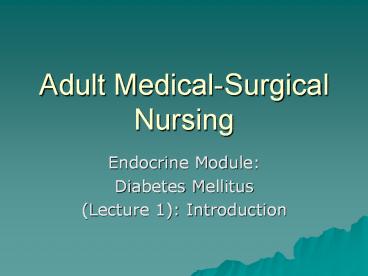Adult Medical-Surgical Nursing
Title:
Adult Medical-Surgical Nursing
Description:
Adult Medical-Surgical Nursing Endocrine Module: Diabetes Mellitus (Lecture 1): Introduction The Role of Insulin Anabolic role: regulates the uptake and storage of ... –
Number of Views:216
Avg rating:3.0/5.0
Title: Adult Medical-Surgical Nursing
1
Adult Medical-Surgical Nursing
- Endocrine Module
- Diabetes Mellitus
- (Lecture 1) Introduction
2
The Role of Insulin
- Anabolic role regulates the uptake and storage
of glucose by the cells insulin binds to cell
surface receptors allowing uptake of glucose
(storage as glycogen) - Controls the level of glucose in the blood
(together with glucagon)
3
Diabetes Mellitus Definition
- Diabetes is a metabolic problem of hyperglycaemia
resulting from defects in either or both of the
following - Insulin production pancreatic ß cells may stop
secreting insulin (type 1) - Insulin action the body cells may stop
responding to insulin (insulin resistance) (type
2)
4
Diabetes Mellitus Classification
- Type 1 (5-10 of cases)
- Type 2 (90-95 of cases)
- Gestational DM (in pregnancy, similar to type 2
but resolves at end of pregnancy may lead to
type 2 at later date)
5
Complications of Diabetes Mellitus
- Hyperglycaemia leads to both acute and longterm
complications
6
Acute Complications of Diabetes Mellitus
- Diabetic ketoacidosis (type 1 DM)
- Hyperglycaemic hyperosmolar non-ketotic syndrome
(type 2 DM) - Hypoglycaemia and coma
7
Longterm Complications of Diabetes Mellitus
- Macrovascular ? coronary artery disease,
cerebro-vascular disease, peripheral vascular
disease - Chronic microvascular ? nephropathy, retinopathy
- Neuropathy
8
Diabetes Mellitus USA Factsheet
- Leading cause of blindness in working-age adults,
non-trauma amputation and end-stage renal disease - Leading cause of hospitalisation
- Third leading cause of death from disease mainly
coronary artery disease and cerebro-vascular
disease - Source Centre for Disease Control, 2008
American Diabetic Association, 2008 in Brunner
Suddarth, 12th edition, 2010
9
Diabetes Mellitus Type 1
- Absence of insulin secretion due to auto-immune
destruction of the ß cells of the Islets of
Langerhans - Usually onset at a younger age(lt30 years)
- Acute onset requiring urgent treatment
- Genetic predisposition HLA tissue-typing DR3/DR4
has ? risk up to 20 times, but stressors may
trigger or enhance disorder - Insulin required as treatment
10
Type 1 Diabetes Mellitus Pathophysiology
- Auto-immune destruction of ß cells ? insulin and
unchecked hyperglycaemia - If gt renal threshold (9.9 m mol/l) kidneys may
not reabsorb glucose ? glycosuria - Osmotic diuresis polyuria, dehydration
- No insulin to control catabolic action of
glucagon (glycogen, fat, protein) - Breakdown of fat ? ketone bodies (Diabetic
ketoacidosis)may? coma/ death
11
Type 1 DM Clinical Manifestations (Acute Onset)
- Polyuria (? urine output)
- Polydipsia (thirst)
- Polyphagia (? appetite)
- Weight loss
- Fatigue, weakness
- Dehydration, dry skin
- Recurrent infections, poor wound healing
- Maybe ? vision, numb, cool extremities
12
Diabetes Mellitus Type 2
- Reduced cell sensitivity to insulin (insulin
resistance) therefore reduced uptake of glucose
reduced action of insulin - Age of onset usually gt30 years
- Insidious, gradual onset (75 detected
incidentally and may have complications) - Family history common
- Associated with obesity Diet to ? weight, and
exercise are first line of treatment
13
Type 2 Diabetes Mellitus Pathophysiology
- Insulin resistance reduces uptake of glucose by
cells - In an attempt to control (reduce) blood glucose
level, ß cells ? insulin production - Eventually inadequate insulin, relative to
elevated glucose levels ? hyperglycaemia (type 2
DM) (exhaustion of ß cells) - As some insulin present, uncontrolled fat
breakdown and ketoacidosis is prevented
14
Type 2 DM Clinical Manifestations (Gradual Onset)
- Polyuria
- Polydipsia
- Maybe associated with obesity (central)
- Fatigue, weakness
- Dehydration, dry skin
- Recurrent infections, poor wound healing
- Maybe ? vision, numb, cool extremities
- May be unaware until complications arise
15
Diabetes Mellitus Diagnosis
- Patient history and clinical picture
- Random blood glucose
- Fasting blood glucose
- Oral glucose tolerance test (GTT)
- Glycosylated Haemoglobin (Hb A1C)
- Screen for complications BP, ECG, arterial
pulses, lipid profile, kidney function test,
urine protein (24 hour), eye examination,
neurological assessment
16
Positive Diagnosis of Diabetes Mellitus
- Random (RBS) gt11.1 m mol/l (200mg/dl)
- Fasting (FBS) gt7 m mol/l (126mg/dl) (With
symptoms or more than once) - GTT (fasting, 50-75g glucose orally) if 2 hours
postprandial, 11.1 m mol/l or above - Glycosylated Haemoglobin (Hb A1C) gt6
- (When blood glucose elevated, molecules attach to
haemoglobin for lifespan of RBCs average 2-3
month glucose level)
17
Diabetes Mellitus Treatment Plan
- Control blood glucose levels
- Prevent acute or longterm complications which
occur with lack of control




















![book❤️[READ]✔️ Adult-Gerontology Practice Guidelines 3rd Edition](https://s3.amazonaws.com/images.powershow.com/10074256.th0.jpg?_=20240708127)
![book❤️[READ]✔️ Adult-Gerontology Practice Guidelines 3rd Edition](https://s3.amazonaws.com/images.powershow.com/10074302.th0.jpg?_=20240708011)
![book❤️[READ]✔️ Adult-Gerontology Practice Guidelines 3rd Edition](https://s3.amazonaws.com/images.powershow.com/10074334.th0.jpg?_=20240708014)
![[PDF] Foundations and Adult Health Nursing 9th Edition Android](https://s3.amazonaws.com/images.powershow.com/10076360.th0.jpg?_=20240710094)


![[PDF] Pharmacology and the Nursing Process 9th Edition Kindle](https://s3.amazonaws.com/images.powershow.com/10085907.th0.jpg?_=20240726122)




![[Download ]⚡️PDF✔️ Medical-Surgical Nursing: Concepts for Clinical Judgment and](https://s3.amazonaws.com/images.powershow.com/10128553.th0.jpg?_=20240911121)